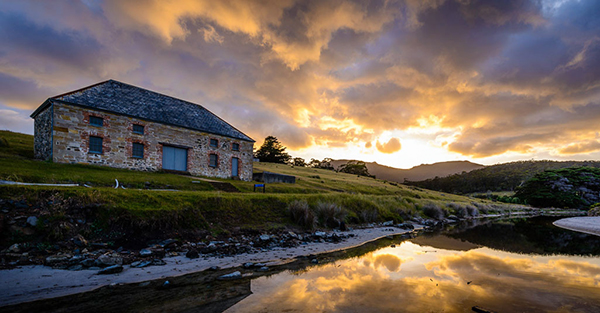
| Search JoyZine with Google Site Search! |
Maria Island
The first European to sight Maria Island was Abel Tasman, in December 1642. It was Tasman who, having named the main island after Anthony Van Diemen, the Governor-in-Chief of the Dutch East India Company in Batavia, named this small, east coast island Maria, after the Governor-in-Chief's wife. The first Englishman to land on the island was Captain John Cox, who arrived in 1789, anchored at Shoal Bay, and made contact with the local Aborigines, the Tyreddeme Aboriginal people of the Oyster Bay area. In 1802, French explorer Nicolas Baudin charted Maria Island, spending five days investigating the island. The diversity of these early explorers is summed up by the variety of names given to the coastline—everything from Ile du Nord to Chinaman's Bay, Mistaken Cape and Cape Boulanger.Maria Island is separated from mainland Tasmania by Mercury Passage and measures 19km long and 13km wide, with an area of 9672 hectares (24,000 acres). The island has two large bays, Riedle on the eastern side and Oyster on the western side, separated by a narrow, sandy isthmus. It has a mountain which rises to 710 meters and is surrounded with steep, heavily fossilized cliffs overlooking the sea. The vegetation cover of the island consists of open forests and gullies filled with ferns. The island has experienced four distinct periods of European settlement. The first 'settlers' were whalers and sealers who lived a hard and temporary life on the island in the early nineteenth century. They viciously exploited the local Aborigines while plundered the local seal population. In 1825 the sealers gave way to a penal colony (the second to be established in Van Diemen's Land), established by Governor George Arthur to ease the ever-increasing pressure on Hobart Town. Arthur sent 50 convicts, accompanied by a superintendent and a small party of soldiers, to the island. Although their stay was relatively short (the colony closed in 1832 after the larger prison at Port Arthur was established) they built a number of buildings of which only the Commissariat Store and the prisoner's barracks, known as the Penitentiary, still stand. The settlement, which was located at Darlington, was conceived as a half-way house between the extreme of hard labour at Macquarie Harbour and a stint in a road or chain gang. Convicts sent to Maria Island worked in a number of different industries including timber-cutting, tanning, shoe-making and cloth production. An unusual feature of the settlement was that it was fitted out with a mechanised textile factory powered by water. Plagued by frequent escape and other disciplinary problems, Maria Island was closed down and much of the remaining convict population relocated to Port Arthur in 1832. After being abandoned for ten years, the site was reopened in 1842 as a probation station. Lt.-Governor Franklin repaired the original buildings and reopened the island as a penal colony and the island's population expanded dramatically. A second convict station was established at Point Lesueur; over 800 convicts arrived on the island, and an extensive building program was commenced. Overcrowding remained a constant problem, however, and both stations were closed down in 1850. Among the convicts who served time at Maria Island were the Young Irelander William Smith O'Brien, two Khoi (from the Cape Colony), and five Maori transported as a result of frontier colonial conflict. Again the settlement was short-lived. It was abandoned for the last time in 1851 and a few farmers arrived to take advantage of the good sheep pastures and the mild climate. In 1884 Maria Island began a new phase in its history when an Italian silk merchant, Diego Bernacchi, leased the entire island. Bernacchi was a dreamer who, attracted by the mild climate and good soils, decided to turn Maria Island into a Mediterranean paradise. He planted 50 000 vines (one of his wines came third in the 1888 Melbourne Centennial Exhibition) and built a 30-room Grand Hotel and Coffee Palace. So enthusiastic was Bernacchi that he attracted a State School (now used as the Ranger's office), general store, butcher and baker to the island. The project failed and Bernacchi abandoned the island around 1895. Undeterred he returned in 1920 to build a pier and railway line to exploit the island's deposits of cement. Like every other activity on the island, the cement works was short-lived. By 1930 the cement works lay silent and the farmers had, once again, quietly assumed economic preeminence. In 1972 the whole island became a National Park. At Point Lesueur, the vivid orange bricks of the early convict punishment cells are a contrast against the blue skies and golden tussock grass. At Haunted Bay, we stand on the granite cliffs which shelter nesting penguins, while sea eagles wheel overhead. Relics of farming families remain, too. The walls of Howells Cottage are papered in the daily news from 1924; the house was inhabited until the 1960s when farming was bought to a halt by the declaration of a fauna reserve for the whole island. Joseph Howells was an English convict transported for sheep stealing in 1852 and stayed on after he was pardoned, raising his family of 10 children here. |
